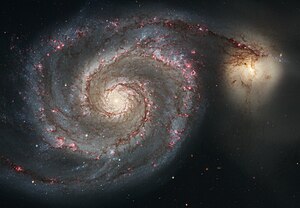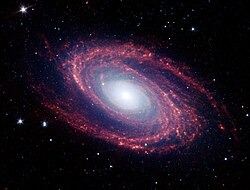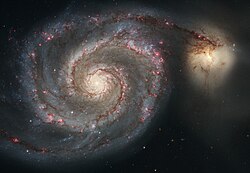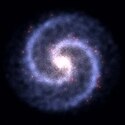Spiralarm

Als Spiralarme werden spiralförmige Ausleger von Galaxien bezeichnet. Sie sind aus Gas und hellen Sternen zusammengesetzt und durch weniger helle, nur augenscheinlich leere Zwischenräume voneinander getrennt. Galaxien mit dieser Struktur werden daher auch Spiralgalaxien genannt.
Astronomische Bedeutung
Die Spiralarme sind Gebiete der bis heute anhaltenden Sternentstehung und wurden erstmals visuell Anfang des 19. Jahrhunderts beobachtet und um 1880 erstmals fotografiert. Im Andromedanebel M 31 konnte Edwin Hubble in den 1920er Jahren die äußersten Bereiche in Einzelsterne auflösen und dadurch nachweisen, dass die Spiralgalaxien nicht, wie zunächst angenommen, Gas- oder Staubnebel, sondern gewaltige Sternsysteme sind. Die Existenz von Spiralarmen der Milchstraße wurde erstmals 1951 von einem Team um William Morgan nachgewiesen.
Die Spiralarme entstehen aus dem Zusammenwirken von Gravitation und Sternentstehung und enthalten daher große Mengen Gas. Der gasförmige Wasserstoff lässt sich durch seine 21-cm-Radiostrahlung (HI-Linie) seit etwa 1950 nachweisen und erlaubt, die Struktur unserer Milchstraße auch hinter dem Milchstraßenzentrum zu erforschen, das im optischen Bereich des Spektrums von großen Dunkelwolken verdeckt wird.
Entstehung

Auch wenn es bei einer Spiralgalaxie so aussieht, als würde sie nur innerhalb ihrer Spiralarme existieren, so sind die Bereiche zwischen den Spiralarmen nicht leer, sondern einfach nur weniger leuchtstark. Auch hier befinden sich verhältnismäßig viele Sterne.
Welche Prozesse für die Entstehung der Spiralstruktur verantwortlich sind, ist bislang noch nicht eindeutig geklärt. Jedoch ist klar, dass die zu den Spiralarmen gehörigen Sterne keine starre Struktur bilden, die sich in Formation um das jeweilige Galaxienzentrum dreht. Wäre dies der Fall, würde sich die Armstruktur einer Spiralgalaxie aufgrund der unterschiedlichen Bahngeschwindigkeiten innerhalb relativ kurzer Zeit aufwickeln und unkenntlich werden. Eine Galaxie rotiert also nicht starr wie ein Rad; vielmehr laufen die einzelnen Sterne während ihres Umlaufs um das Zentrum aus den Spiralarmen heraus und hinein.
Eine Erklärung bietet die These, dass die Spiralarme sichtbarer Ausdruck stehender Dichtewellen sind (etwa wie Schallwellen in Luft), die in der galaktischen Scheibe umlaufen. Diese Dichtewellentheorie wurde zuerst von Chia-Chiao Lin und Frank Shu in den 1960er Jahren aufgestellt. Dabei sind die Spiralarme Zonen erhöhter Materiedichte und Sternentstehung, die sich mit anderer Geschwindigkeit als die einzelnen Sterne durch die Scheibe bewegen. Während ihrer Lebenszeit bewegen sich Sterne von ihren Geburtsstätten weg und verteilen sich auf die Scheibe. Besonders massereiche und leuchtkräftige Sterne entfernen sich allerdings aufgrund ihrer kürzeren Lebensdauer nicht soweit von ihren Entstehungsgebieten, weswegen diese dann als helle Spiralarme hervortreten. Daher gehören zu den dort befindlichen stellaren Objekten vor allem Sterne der Spektralklassen O und B, Überriesen und Cepheiden, alle jünger als 100 Millionen Jahre. Sie stellen jedoch nur einen geringen Prozentsatz der Sterne in einer Spiralgalaxie dar. Der größte Teil der Masse eines solchen Sternensystems besteht aus alten, massearmen Sternen, die sich im Laufe ihres langen Lebens weit von den Spiralarmen entfernen können.
Die Dichtewellen entstehen durch das Zusammenspiel aller Sternumlaufbahnen, denn die Sterne bewegen sich nicht wie etwa die Planeten im Sonnensystem gleichmäßig um ein festes Zentrum (ein Schwarzes Loch im Galaxienzentrum), weil dafür die Gesamtmasse der Galaxie nicht konzentriert genug ist. Daher kehrt ein Stern nach einer Umrundung des Galaxienzentrums nicht wieder an seinen Ausgangspunkt zurück, die Bahnen sind also keine Ellipsen, sondern besitzen die Form von Rosetten. Dichtewellen entstehen, wenn sich viele Sterne gleich schnell bewegen. So sind in einer Balkenspiralgalaxie alle Bahnen gleich gegeneinander ausgerichtet, in einer reinen Spiralgalaxie dagegen noch gegeneinander verschoben. Die Synchronisierung der Bahnen erfolgt durch gravitative Rückkopplung.
Mittels Computersimulationen, die auch interstellares Gas berücksichtigen, kann die Ausbildung von Spiralarmen modelliert werden. Dabei zeigt sich, dass diese keineswegs statisch sind, sondern entstehen und vergehen. Danach durchläuft jede Galaxie eine zyklische Umwandlung von der Balken- in die reine Spiralform und zurück mit einer Periode von ca. 10 Milliarden Jahren. Ferner stören die Spiralarme die Bahnkurven der Sterne, was zu den sogenannten Lindblad-Resonanzen führt.
Auf dieser Seite verwendete Medien
Autor/Urheber: NASA, ESA, S. Beckwith (STScI), and The Hubble Heritage Team STScI/AURA), Lizenz: CC BY 3.0
The Whirlpool Galaxy (Spiral Galaxy M51, NGC 5194) is a classic spiral galaxy located in the Canes Venatici constellation.
Out of this whirl: The Whirlpool Galaxy (M51) and companion galaxy
The graceful, winding arms of the majestic spiral galaxy M51 (NGC 5194) appear like a grand spiral staircase sweeping through space. They are actually long lanes of stars and gas laced with dust.
This sharpest-ever image, taken in January 2005 with the Advanced Camera for Surveys aboard the NASA/ESA Hubble Space Telescope, illustrates a spiral galaxy's grand design, from its curving spiral arms, where young stars reside, to its yellowish central core, a home of older stars. The galaxy is nicknamed the Whirlpool because of its swirling structure.
The Whirlpool's most striking feature is its two curving arms, a hallmark of so-called grand-design spiral galaxies. Many spiral galaxies possess numerous, loosely shaped arms that make their spiral structure less pronounced. These arms serve an important purpose in spiral galaxies. They are star-formation factories, compressing hydrogen gas and creating clusters of new stars. In the Whirlpool, the assembly line begins with the dark clouds of gas on the inner edge, then moves to bright pink star-forming regions, and ends with the brilliant blue star clusters along the outer edge.
Some astronomers believe that the Whirlpool's arms are so prominent because of the effects of a close encounter with NGC 5195, the small, yellowish galaxy at the outermost tip of one of the Whirlpool's arms. At first glance, the compact galaxy appears to be tugging on the arm. Hubble's clear view, however, shows that NGC 5195 is passing behind the Whirlpool. The small galaxy has been gliding past the Whirlpool for hundreds of millions of years.
As NGC 5195 drifts by, its gravitational muscle pumps up waves within the Whirlpool's pancake-shaped disk. The waves are like ripples in a pond generated when a rock is thrown in the water. When the waves pass through orbiting gas clouds within the disk, they squeeze the gaseous material along each arm's inner edge. The dark dusty material looks like gathering storm clouds. These dense clouds collapse, creating a wake of star birth, as seen in the bright pink star-forming regions. The largest stars eventually sweep away the dusty cocoons with a torrent of radiation, hurricane-like stellar winds, and shock waves from supernova blasts. Bright blue star clusters emerge from the mayhem, illuminating the Whirlpool's arms like city streetlights.
The Whirlpool is one of astronomy's galactic darlings. Located 31 million light-years away in the constellation Canes Venatici (the Hunting Dogs), the Whirlpool's beautiful face-on view and closeness to Earth allow astronomers to study a classic spiral galaxy's structure and star-forming processes.
Credit:
NASA, ESA, S. Beckwith (STScI), and The Hubble Heritage Team STScI/AURA)
About the Image
NASA caption Id: heic0506a Type: Observation Release date: 25 April 2005, 06:00 Related releases: heic0506 Size: 11477 x 7965 px
About the Object
Name: Messier 51, Whirlpool Galaxy Type: • Local Universe : Galaxy : Type : Spiral • Galaxies Images/Videos Distance: 25 million light years
Colours & filters
Band Wavelength Telescope Optical B 435 nm Hubble Space Telescope ACS Optical V 555 nm Hubble Space Telescope ACS Optical H-alpha + Nii 658 nm Hubble Space Telescope ACS Infrared I 814 nm Hubble Space Telescope ACS.
Autor/Urheber: Ingo Berg, Lizenz: CC BY-SA 3.0
Spiralarme einer Galaxie die durch ein vereinfachtes Modell von Dichtewellen erzeugt werden. In diesem Beispiel verändern die Spiralarme ihre Position nicht, Sterne können sich jedoch hinein und heraus bewegen.
Barred spiral galaxy NGC 1300 photographed by Hubble telescope.
In the core of the larger spiral structure of NGC 1300, the nucleus shows its own extraordinary and distinct "grand-design" spiral structure that is about 3,300 light-years (1 kiloparsec) long. Only galaxies with large-scale bars appear to have these grand-design inner disks — a spiral within a spiral. Models suggest that the gas in a bar can be funneled inwards, and then spiral into the center through the grand-design disk, where it can potentially fuel a central black hole. NGC 1300 is not known to have an active nucleus, however, indicating either that there is no black hole, or that it is not accreting matter.
The spiral arms of the nearby galaxy Messier 81 are highlighted in this NASA Spitzer Space Telescope image. Located in the northern constellation of Ursa Major (which also includes the Big Dipper), this galaxy is easily visible through binoculars or a small telescope. M81 is located at a distance of 12 million light-years.
Because of its proximity, M81 provides astronomers with an enticing opportunity to study the anatomy of a spiral galaxy in detail. The unprecedented spatial resolution and sensitivity of Spitzer at infrared wavelengths show a clear separation between the several key constituents of the galaxy: the old stars, the interstellar dust heated by star formation activity, and the embedded sites of massive star formation. The infrared images also permit quantitative measurements of the galaxy's overall dust content, as well as the rate at which new stars are being formed.




